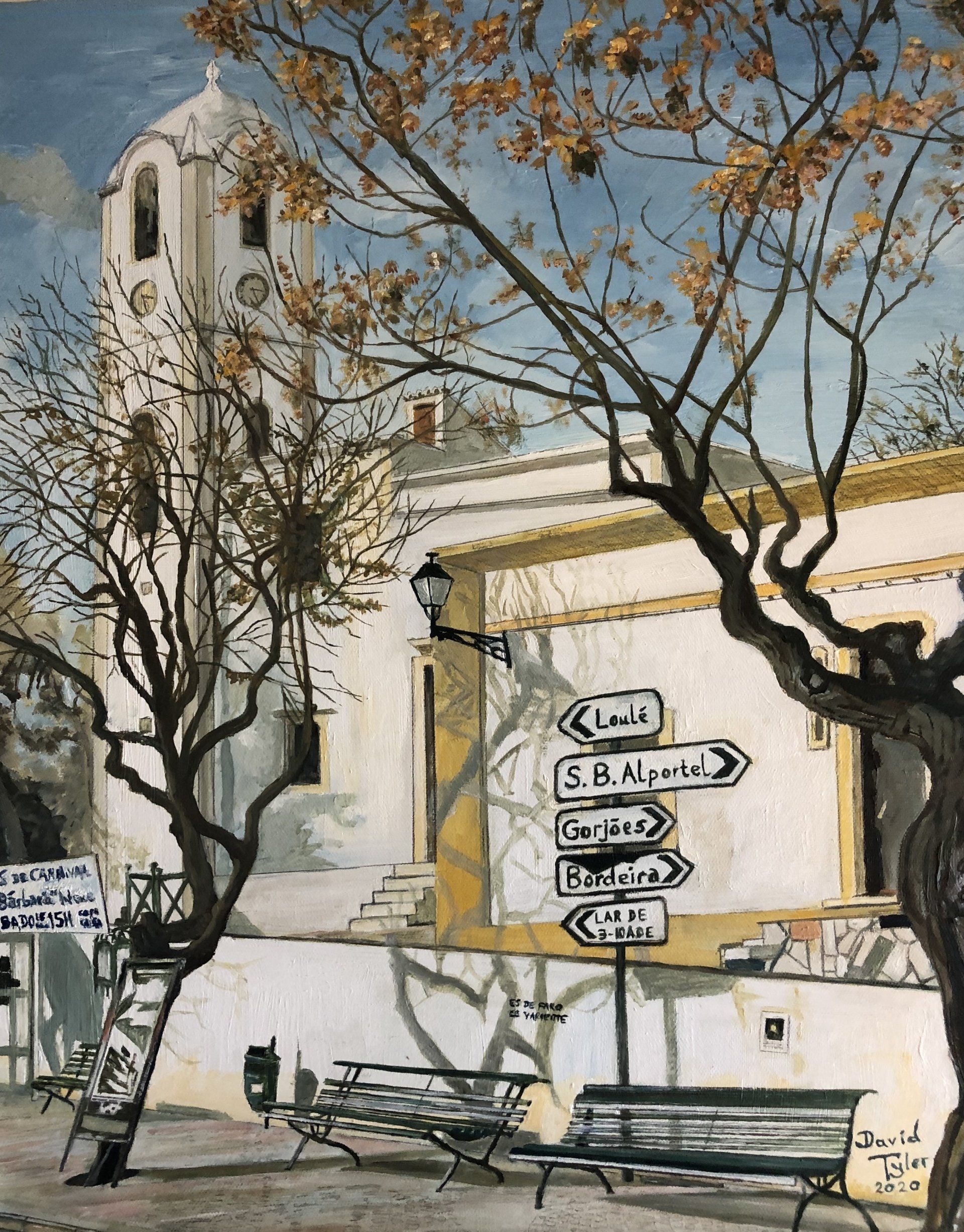Blog Layout
The Church of Santa Bárbara de Nexe
28 January 2020
The tall, white bell tower is the most striking feature of the church of Santa Bárbara de Nexe, which was developed from a chapel dating back to 1444, supported by the Order of St. James. Inside, the vaulted ceiling has a complex Gothic-like spine. At the beginning of every year, the Charolas, groups of singers, accompanied by accordions, castanets, tambourines, triangles and sometimes clarinets and saxophones, play in the festivals of Bordeira and Santa Bárbara de Nexe entertaining people in the local cafés. They perform improvised chants and songs to mark the New Year, in a spirit of friendship and solidarity, but often with some element of socio-political satire. The Charolas are manifestations of the traditional culture of Santa Bárbara de Nexe, unique to this region of Portugal, set in the hillsides above Faro. They include popular poetry and theatrical improvisation, but avoid religious symbology. The Charolas reached their zenith during the mid 20th century with the accordionists of Bordeira, including José Ferreiro and João Barra Bexiga, as well as the popular poetry of António Aleixo and Clementino Baeta.
For my January 2020 blog I have chosen a painting that I completed recently. It depicts the church of Santa Bárbara de Nexe, set against a pastel blue sky, with signposts to local places such as Bordeira, Loulé, Gorjöes, São Brás de Alportel and Lar de 3-Idade. The two trees in front of the whitewashed wall create interesting shapes in the gentle breeze.
I had two reasons for selecting this picture which is painted in oils on a canvas treated with an acrylic wash. As it is January I was looking for some connection with the New Year and this is provided by the Charolas. It is also Bill and Bernadette’s 50th wedding anniversary at the end of the month. Bill is my wife’s brother. He and Bernadette live for two thirds of the year in Portugal at a property near Santa Bárbara de Nexe, just north of the village of Bordeira, with views looking out towards Quinta do Lago Beach. The painting will be a present to them as they celebrate this notable landmark in their lives. Congratulations to Bill and Bernadette!
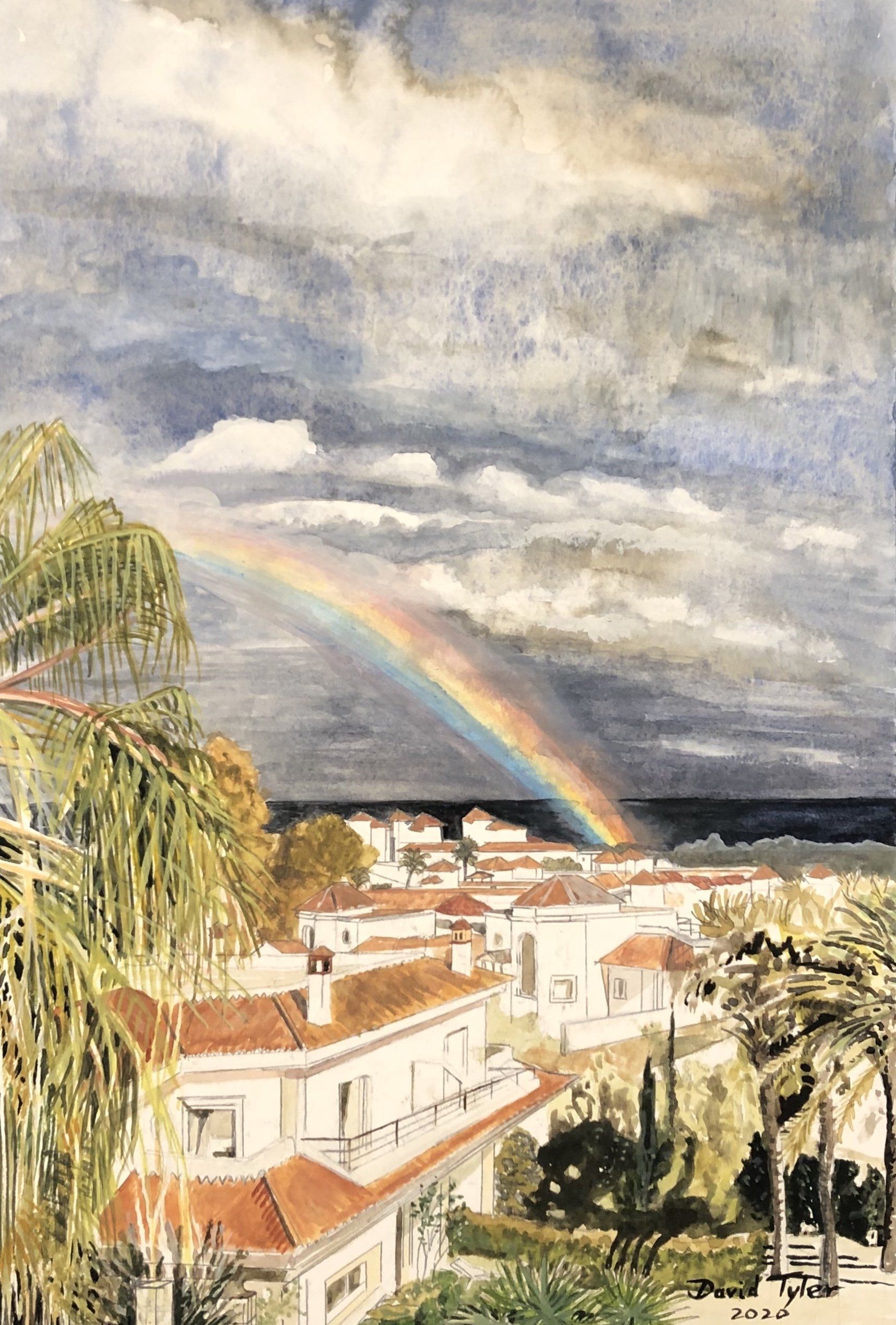
by David Tyler
•
31 May 2020
Esta es la acuarela terminada con el arcoíris, la palmera a la izquierda y los edificios terminados. La canción 'Búscame en Rainbows', cantada por Vicki Brown, ahora tiene un lugar especial en mi corazón, ya que la usamos en el funeral de mi padre el miércoles 13 de mayo de 2020. Esta pintura está dedicada a la memoria de mi padre, Colin Tyler (13 de julio de 1932 - 29 de abril de 2020). Falleció mientras dormía en Merlin Court Care Home en Wiltshire contrayendo neumonía y Covid-19. Fue un gran padre y logró mucho en sus más de 87 años. De una clase trabajadora, obtuvo una beca estatal para Emmanuel College, Cambridge, para leer Derecho. Se convirtió en socio principal de Wragge & Co en Birmingham y fue reconocido como uno de los abogados corporativos más exitosos en el Reino Unido fuera de Londres. Sus cuatro nietos lograron asistir al funeral junto con mi hermano, Richard.

by David Tyler
•
31 May 2020
Etapa uno de esta acuarela que representa una vista tormentosa sobre el Mediterráneo desde nuestro apartamento en The San Roque Club en España durante el bloqueo de Coronavirus. Se usó cinta de enmascarar para proteger el área del arcoíris, la palmera a la izquierda y los edificios a media distancia. Bastante complicado y probablemente más fácil de lograr con el líquido de enmascaramiento.

by David Tyler
•
31 May 2020
This is the finished watercolour with the rainbow, palm tree on the left and buildings completed. The song ‘Look for me in Rainbows’, sung by Vicki Brown, now has a special place in my heart as we used it at my father's funeral on Wednesday 13 May 2020. This painting is dedicated to the memory of my father, Colin Tyler (13 July 1932 - 29 April 2020). He passed away in his sleep at Merlin Court Care Home in Wiltshire having contracted pneumonia and Covid-19. He was a great father and achieved a great deal in his 87 plus years. From a working class background, he got a state scholarship to Emmanuel College, Cambridge, to read Law. He became a senior partner at Wragge & Co in Birmingham and was recognised as one of the most accomplished corporate lawyers in the UK outside of London. His four grandchildren managed to attend the funeral along with my brother, Richard.

by David Tyler
•
31 May 2020
Stage one of this watercolour which depicts a stormy view out over the Mediterranean from our apartment at The San Roque Club in Spain during the Coronavirus lockdown. Masking tape was used to protect the area for the rainbow, the palm tree on the left and the buildings in the middle distance. Quite fiddly to do and probably easier to accomplish with masking fluid.
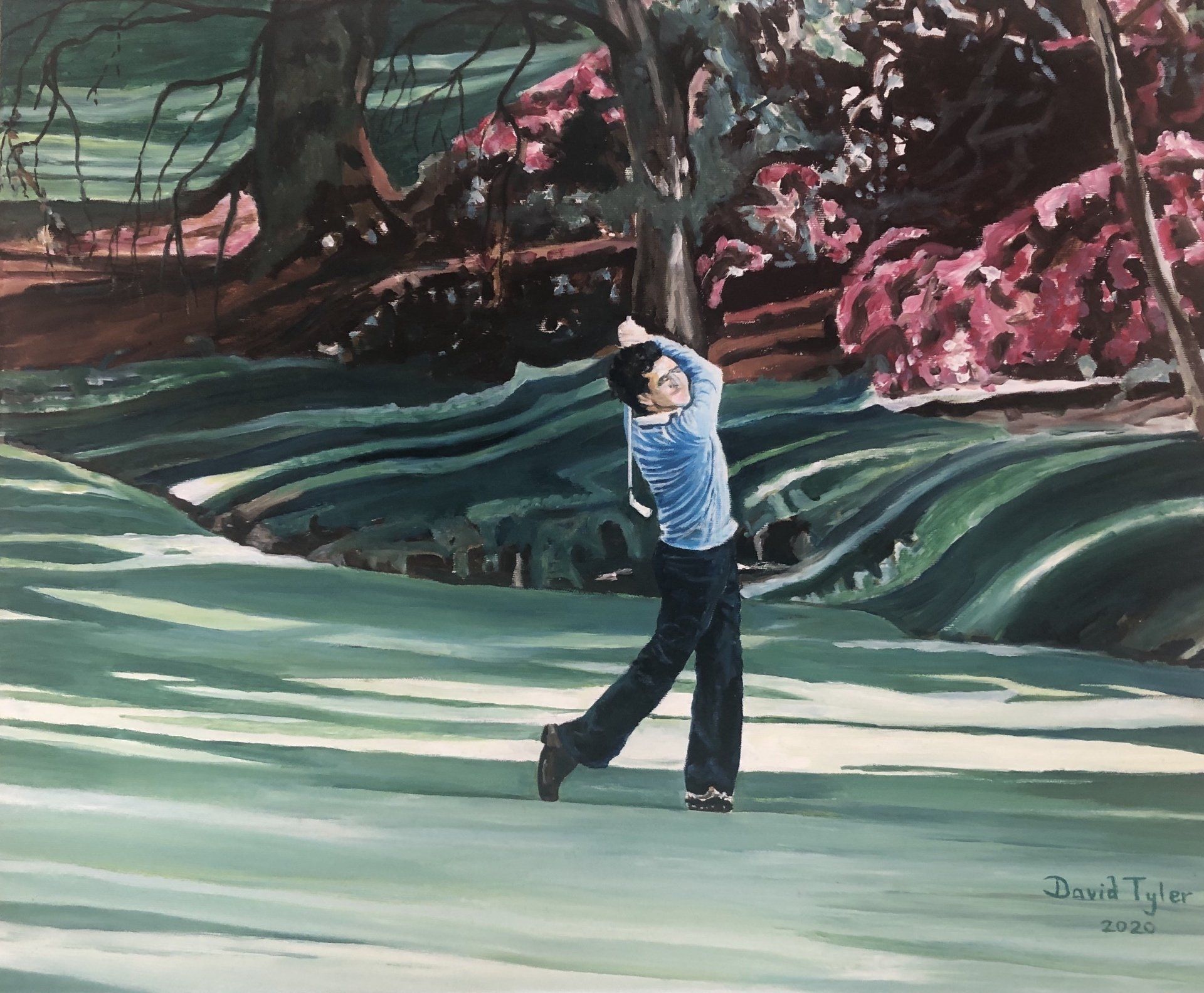
by David Tyler
•
31 May 2020
Seve ganó su segundo título de Masters en Augusta en abril de 1983. Fue su tercer título importante. Terminó cuatro golpes antes de los subcampeones Ben Crenshaw y Tom Kite. El mal tiempo hizo que la ronda final se jugara el lunes 11 de abril de 1983. Seve terminó en -8 con rondas de 68, 70, 73 y 69. El lunes, Seve tuvo un comienzo rápido con un birdie en el primer hoyo, un águila en el segundo, otro birdie en el cuarto hoyo par 3 difícil, seguido de cuatro pares y otro birdie en el noveno, un cinco debajo del par 31 en el frente nueve. Cruzó a la victoria cuando Stadler, Floyd y Watson no lograron llegar a la par y Crenshaw, Kite e Irwin estaban demasiado lejos para montar un desafío decisivo. El hoyo 13 del par 5 de pierna de perro en Augusta es un maravilloso hoyo de riesgo / recompensa con peligro a la izquierda y un arroyo frente al green.

by David Tyler
•
31 May 2020
Seve won his second Masters title at Augusta in April 1983. It was his third major title. He finished four strokes ahead of runners-up Ben Crenshaw and Tom Kite. Bad weather caused the final round to be played on Monday 11 April 1983. Seve finished on -8 with rounds of 68, 70, 73 and 69. On the Monday, Seve got off to a fast start with a birdie on the first hole, an eagle on the second, another birdie on the difficult par 3 fourth hole, followed by four pars and another birdie on the ninth, a five under par 31 on the front nine. He cruised to victory as Stadler, Floyd and Watson failed to break par and Crenshaw, Kite and Irwin were all too far back to mount a decisive challenge. The dog-leg par 5 13th hole at Augusta is a wonderful risk/reward hole with danger down the left and a stream in front of the green.
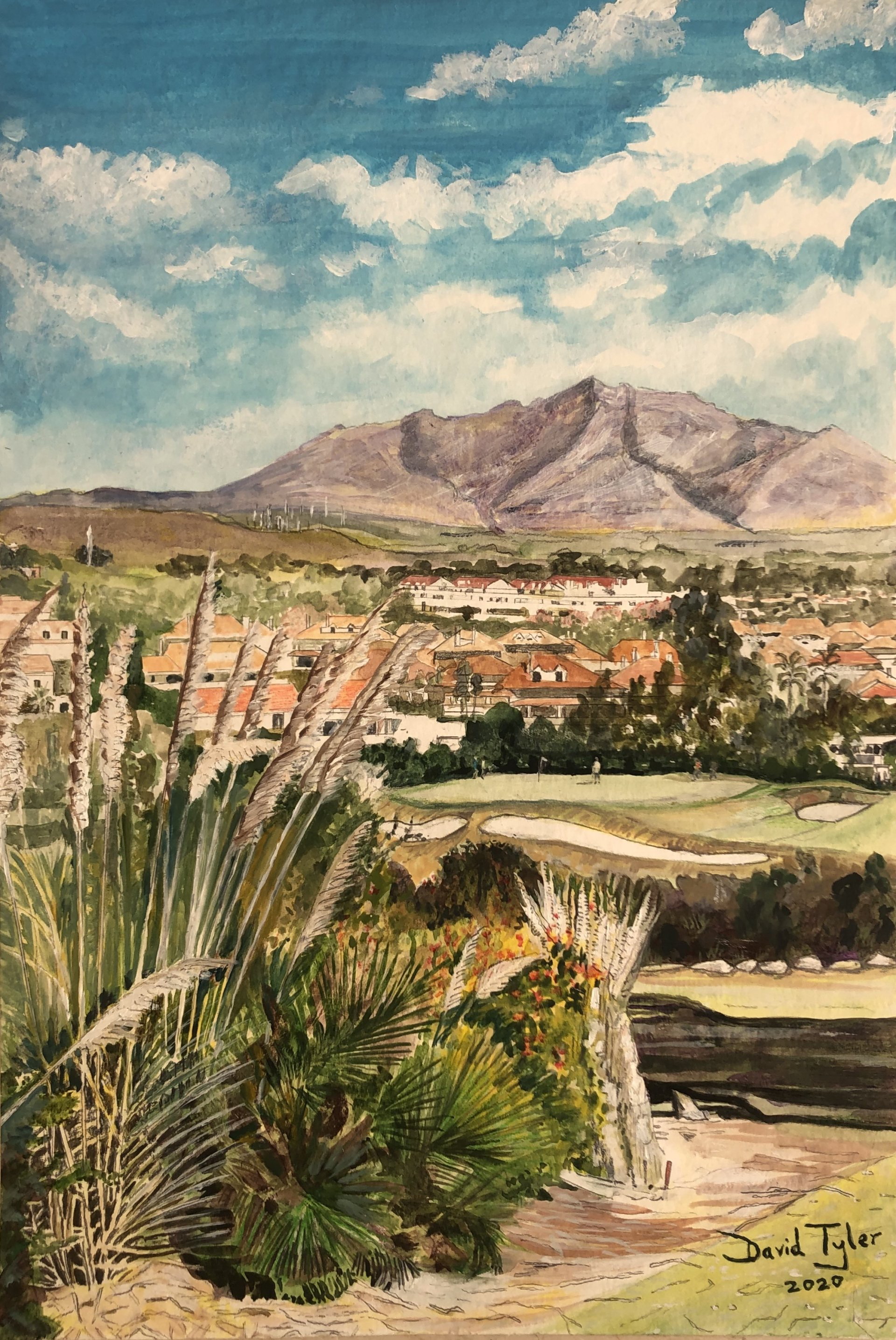
by David Tyler
•
9 March 2020
Este complicado par 3 se juega a través de un profundo barranco arbolado, por lo que cualquier bola que no llegue al green caerá en el búnker de espera, al frente a la izquierda o desaparecerá en la barranca. Hay una zona de caída frente al área de salida delantera. El green está rodeado por siete bunkers, por lo que no es fácil rescatarlo si se equivoca a la derecha. Incluso si encuentra la superficie de juego con su golpe de salida, el par no es simple, ya que el green tiene más de 40 yardas de profundidad y está lleno de ondulaciones. Es muy fácil tres putt. Si no cree que el desafío desde el tee amarillo (179 yardas) o el tee blanco (194 yardas) sea lo suficientemente difícil, siempre está el tee Seve adyacente al tercer green (255 yardas desde el centro del green). Desde aquí tiene una de las mejores vistas del campo de golf.

by David Tyler
•
9 March 2020
This tricky par 3 is played across a deep tree-lined ravine so any ball not reaching the green will drop into the waiting bunker, front left, or disappear into the barranca. There is a dropping zone in front of the forward teeing area. The green is surrounded by seven bunkers so there is no easy bail out if you err to the right. Even if you find the putting surface with your tee shot, par is no simple matter as the green is over 40 yards deep and full of undulations. It is very easy to three putt. If you do not think the challenge from the yellow tee (179 yards) or the white tee (194 yards) is hard enough, there is always the Seve tee adjacent to the third green (255 yards from the middle of the green). From here you have one of the best views on the golf course.
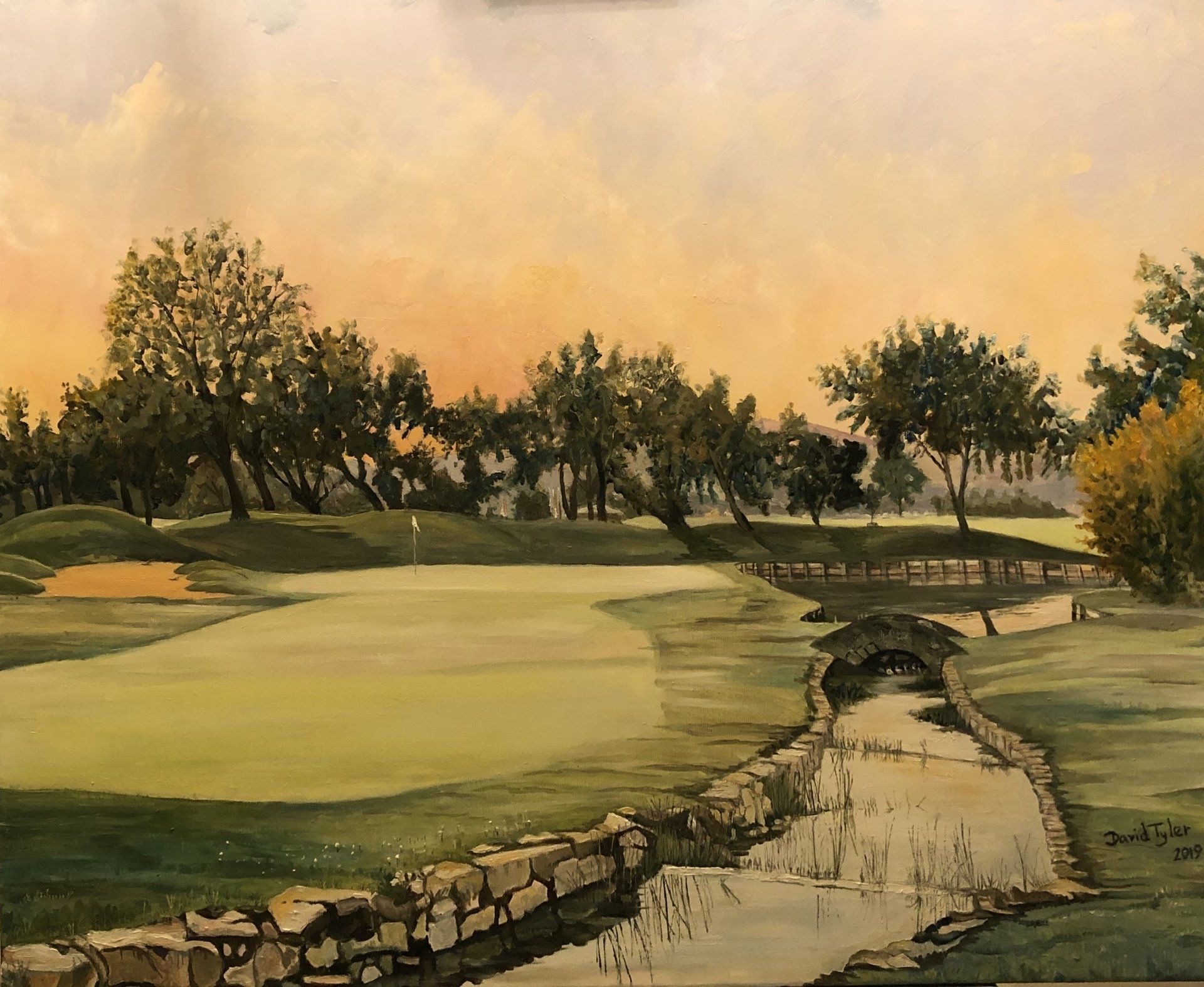
3 December 2019
Hay un tema de golf en mi oferta de diciembre de 2019. Es un momento emocionante en The San Roque Club. El Old Course cerró el 3 de noviembre por una extensa renovación de 12 meses con la instalación de un nuevo sistema de riego y cambios significativos en varios hoyos. Además, el orden de los dos nueves se cambiará cuando el Old Course se vuelva a abrir, por lo que el hoyo 18 de la firma, con sus obstáculos de agua, se convertirá en el noveno. Mi pintura intenta representar este famoso par 4 hoyo con un dog-leg, con agua izquierda desde el tee, bunkers por la derecha, un arroyo para cruzar al acercarse al green, largo y gran, y sin olvidar un estanque peligroso a la derecha superficie de puttiendo, que capturará cualquier disparo errante, bordeado a la derecha con un gran estanque. Es una creación clásica de recompensa de riesgo, realizada por el arquitecto original del curso Dave Thomas. Disculpas a los no golfistas, pero para aquellos interesados, juega a 428 yardas de las tees traseras y a 346 yardas igualmente desafiantes de los marcadores de tee rojos. Paso 1: Comencé con un bloque de lienzo de 73 cm de ancho por 60 cm de alto y dibujé algunos contornos aproximados para obtener la composición básica que quería. La siguiente tarea fue bloquear en algún color para delinear las áreas principales de la pintura. Utilicé una mezcla de sahara amarilla, magenta y blanco titanio con trazas de azul prusiano y azul fthalo para el cielo nocturno. Estos colores fueron recogidos en el pequeño lago a la derecha. Las montañas a lo lejos se representaban en dos tonos de un tenue púrpura gris mezclado con blanco titanio, magenta, azul prusiano y ámbar quemado. Puse tonos azules y grises claros en el área del arroyo que atraviesa la calle. El búnker a la izquierda del green está captando la luz y requiere sahara amarilla y magenta templado por un poco de blanco titanio. A continuación, coloqué el montículo alrededor de la superficie de puttiendo a la izquierda y a la parte trasera usando amarillo limón, azul ftalo, ámbar quemado, siena cruda y blanco de titanio mezclado en varias combinaciones diferentes. La superficie de puttiendo es una mezcla de amarillo limón y blanco de titanio, al igual que la calle en la distancia detrás del montículo. Este último tiene más amarillo. Puse algunos de los árboles para ayudar a establecer el contraste. Siena cruda se usó para el color base para marcar la posición del gran árbol espeso en el extremo derecho. Los árboles en la distancia fueron colocados con ámbar quemado templado por varios verdes de rango medio. Esta etapa se completó con un ligero lavado de verdes pálidos con un alto componente de amarillo limón bien diluido para marcar la calle. Las áreas de rugosidad fueron sugeridas por un color base de verdes medios a oscuros con el color más vibrante más cerca del primer plano para ayudar a establecer la perspectiva.



